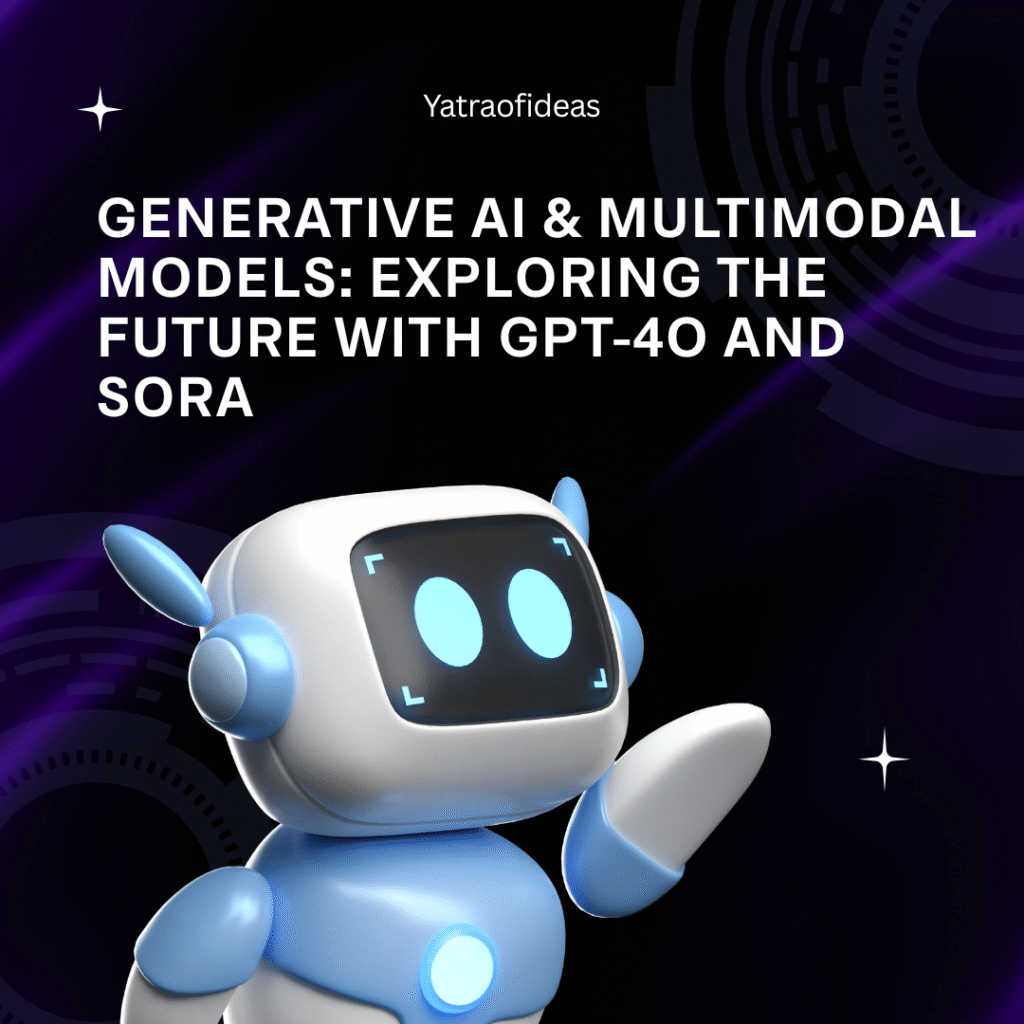GPT-4o and Sora Leading a New AI Wave
Artificial Intelligence (AI) is rapidly evolving and revolutionizing industries across the globe. Among the most transformative developments are generative AI and multimodal AI models. These advanced technologies are changing how we create content, automate workflows, and build intelligent systems.
OpenAI’s GPT-4o and Sora are at the forefront of this movement. These models are setting new benchmarks for performance, creativity, and cross-modal understanding. In this blog, we’ll explore what makes these technologies so powerful, their real-world use cases, and why they’re central to the future of generative AI.
For an in-depth look at GPT-4o, visit the official OpenAI release: https://openai.com/index/gpt-4o
To learn more about Sora, check out OpenAI’s announcement and demo examples: https://openai.com/sora
What is Multimodal AI?
Multimodal AI refers to AI models capable of understanding and processing more than one type of input — such as text, image, audio, and video — all at once. Traditional AI models have usually focused on one input type, like text or image, in isolation. However, multimodal systems aim to understand and relate multiple data types contextually, just as humans do.
Key Benefits of Multimodal AI
- Improved Interaction: Enables seamless communication through voice, visual, and textual inputs
- Greater Understanding: Allows AI to grasp context more accurately using combined data.
- Cross-Domain Applications: Supports a wide range of tasks from education to security and marketing.
Multimodal AI Examples
- GPT-4o (OpenAI): Accepts input from text, images, and speech, and responds using natural language or voice.
- Sora (OpenAI): A text-to-video AI model capable of creating realistic video sequences from written descriptions.
- Meta’s ImageBind: Combines six modalities (text, image, audio, depth, temperature, and motion).
- Google Gemini: Competes with OpenAI with cross-modal capabilities.
These models represent the growing category of AI content creation tools that merge understanding and creativity across input types.
Understanding Generative AI: Beyond Automation
Generative AI is a subset of AI that creates new content from existing data. Unlike traditional AI that recognizes patterns or predicts outcomes, generative models can produce original text, images, audio, video, or even code — often with human-like quality.
Core Components of Generative AI:
- Transformer Architecture: Used in models like GPT-4o for understanding complex patterns.
- Large Language Models (LLMs): Trained on vast datasets to mimic human writing.
- Diffusion Models: Used in tools like Sora and Stable Diffusion for creating visuals and video content.
Popular Applications:
- AI Content Generation Tools: Generate blog posts, ad copies, or product descriptions.
- AI Art Generation: Platforms like MidJourney and Stable Diffusion are reshaping design and entertainment.
- Code Assistance: Tools like GitHub Copilot suggest code snippets, tests, and entire functions.
- Audio & Music Generation: AI models like Suno and Stability AI generate voiceovers, songs, and podcasts.
The wide availability of free AI tools for content creation is democratizing creative processes and enabling individuals and businesses to scale like never before.
GPT-4o: A Leap in Generative AI Capabilities
GPT-4o, where “o” stands for “omni,” is a multimodal AI model capable of handling text, audio, and image inputs — and responding in real-time. It’s not just more powerful, it’s more interactive, more responsive, and far more human-like than earlier iterations.
GPT-4o Use Cases
- Business Communication: Automate customer service, emails, and real-time conversation.
- Healthcare: Summarize patient records, provide insights based on images and reports.
- Marketing Teams: Use for ad copywriting, A/B testing suggestions, and campaign strategies.
- Educators & Students: Review assignments, explain complex topics using text or visual aids.
- Content Creators: Scriptwriting, scene description, blog automation — all within seconds.
Why GPT-4o Stands Out
- Latency is low (milliseconds), enabling live conversations.
- Native voice interaction makes it feel like a real assistant.
- Real-time image analysis opens new doors for product development, diagnostics, and learning.
In essence, GPT-4o is not just a text tool — it’s an intelligent partner for businesses and creators alike. It’s among the best AI tools for content creation due to its flexibility and speed.
Sora: The Future of Text-to-Video AI Models
Sora, the powerful text-to-video AI model from OpenAI, represents a new frontier in video generation. It transforms written prompts into cinematic, coherent, and imaginative video sequences.
Key Features:
- Realism and Coherence: Maintains logical continuity in scenes.
- Multi-second Footage: Can generate extended videos with consistent subjects and motion.
- Editable Prompts: Easy iterations with minor prompt tweaks.
Sora Video Generator in Action
- Advertising Agencies: Create storyboards or full video campaigns without a film crew.
- E-learning Platforms: Convert lessons into animated instructional content.
- Social Media Marketers: Daily reel or short-form video creation.
- Startups: MVPs and explainer videos made from idea to execution within hours.
With automated content creation software like Sora, storytelling becomes accessible to all — no camera, editing skills, or expensive software needed.
AI Tools for Content Creation: Ecosystem Overview
As AI continues to evolve, so does the ecosystem of AI content creator tools. Here’s a guide to the most useful, powerful, and accessible tools in 2025.
Best AI Content Creation Tools (Premium)
- Jasper Content Writing Tool: SEO-optimized blogs, ad copy, and sales pages.
- Copy.ai: Email sequences, sales messages, and product descriptions.
- Synthesia: Video avatars and AI-generated voiceovers.
- Runway ML: Real-time video editing and AI motion design.
Free AI Tools for Content Creation
- ChatGPT: For writing, planning, brainstorming, and image description.
- Canva Magic Write: AI for design captions, social posts, and presentations.
- Pictory: Convert scripts or blogs into YouTube videos.
- Writesonic (Free Tier): Generates content with AI-driven SEO tools.
Emerging Trends:
- Voice-to-Text-to-Video pipelines
- AI Brand Tone Calibration
- Real-time content testing and optimization
These ai content creation software solutions are forming the backbone of automated content generation systems globally.
The Future of Generative AI: A 2025 Outlook
As we approach the mid-decade mark, generative AI is evolving from novelty to necessity. Here’s what to expect:
1. Unified AI Platforms
Multimodal tools like GPT-4o and Sora will converge into single platforms, offering end-to-end creative automation.
2. Democratization of Creativity
With free AI tool for content creation, small businesses and creators can compete at scale with large enterprises.
3. Ethics and Governance
Tools will include watermarking, fact-checking, and attribution to ensure responsible use.
4. Hyper-Personalization
Every user will have a unique AI agent trained on their tone, history, and needs.
5. AI + Human Collaboration
AI won’t replace humans — it will amplify creativity, reduce repetitive work, and increase speed.
From MidJourney future enhancements to Stable Diffusion future models, the AI landscape will keep expanding — impacting entertainment, design, healthcare, and beyond.
Conclusion: The AI-Driven Creative Renaissance
Multimodal models like GPT-4o and Sora are not just technological marvels — they are catalysts for a new era of creative automation and intelligence. As businesses seek efficiency and individuals seek expressive power, generative AI offers solutions that are scalable, customizable, and revolutionary.
Whether you’re curious about what is multimodal AI, exploring generative AI for business, or experimenting with a content generation tool, now is the time to act.
Adopting these tools doesn’t just mean staying relevant — it means leading the future.

